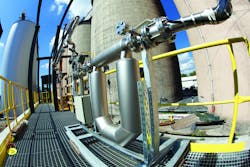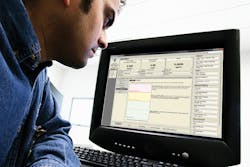What new digital measurement tools can offer processing plants
Remember Scotty from Star Trek? He could always tell when the Enterprise’s engines were off by so much as a fraction of a hair, even when the instruments read that they were within tolerances.
Many of today’s retirement-age plant engineers and technicians have developed similar insights and intuition — particularly when it comes to knowing if a meter is working properly or not, if the flow reading is correct or if there are looming problems. It’s a knowledge that comes from years of experience.
The coming changes
Flowmeters are built to exacting standards, which means that many are still in service 10, 15 and sometimes even 20 years after installation. That’s a great return on investment. However, it does bring some challenges that will need to be addressed in the near term. The main one of those challenges is the fact that these older meters are usually analog, and we are living in a digital world. Add to that, the open positions for the retiring engineers and technicians who have worked with those analog meters throughout their careers, are either not being backfilled or are filled with new grads and young people who are digital natives. The learning curve for these newer hires can be substantial.
Hallway conversations at trade shows and in the C-suite highlight this problem further. For example, a director of a large chemical company recently mentioned that his company is in desperate need of digital measurement outputs because it is losing a large percentage of its workers to retirement and will only replace a portion of them. This means there won’t be enough people to check the meters and analog outputs. The outputs ideally need to be digital and be collected at a centralized data collection point so that fewer people are needed to gather the necessary meter health readings.
Added to that challenge is the fact that companies also need to figure out how to meet growing regulations with a reduced workforce. Automation and reliable diagnostics are a must, especially if those diagnostic outputs are to be accepted by regulatory agencies, which reduces the need for third-party verification or pulling meters out of circulation to be sent to laboratories for testing, verification and calibration. Examples of the different regulatory agencies setting performance parameters include: the U.S. Environmental Protection Agency (EPA), International Organization for Standardization (ISO), American Gas Association (AGA), and the International Electrotechnical Commission (IEC) for Safety Instrumented System Applications.
Available solutions
Laboratory testing and calibrating of meters is certainly good standard practice, and something new hires need to be familiar with. But laboratory-tested meters are tested under ideal, or nonapplication specific conditions. A meter giving a faulty performance in the field might work perfectly in the lab but then go right back to faulty performance in the field, where it is expected to function under less-than-ideal circumstances.
The solution to this issue is diagnostics that are a part of a flowmeter that can indicate exactly what the meter is reading and relay that information back in real-time — in language that most can understand with minimal training.
As much as the next generation needs time to come up to speed on the ins-and-outs of plant processes and meters, the plants and refineries need reliable data that can be accessed at any time without having to wait — the approximate 10 months — for a new hire to learn.
One size fits all?
Diagnostic offerings such as flowmeter digital outputs, taking the industry-tested Smart Meter Verification (SMV) tool attached to a Coriolis meter as an example, should serve multiple people across the organization. What that means in practical terms is that the information the meter provides should be understandable and usable by different personas, job functions or departments within the organization, from the plant technician to the IT person to the quality control professional. The information should be available on-demand, continuously checking meter health, and continuously checking measurement health.
With an integrated diagnostic tool as part of the Coriolis meter setup, it really is a case of one size fits all. The transmitter software diagnostics offers in situ continuous readings of the meter and measurement. With a wireless package added, new recruits should be able to read the meter with minimal training right from their tablets or phones. This is a positive start of their training and can be done without interruptions to the flow of material or end product. Learning to understand a meter and develop an intuitive sense of when things are not running optimally may still come over time, but with the right tools, their learning curve won’t negatively impact plant production.
Diagnostics as part of everyday performance
A noteworthy benefit of having the right tools is that their outputs can meet the requirements for having a clear and transparent audit trail. Advanced reporting software that meets third-party regulatory agency compliance requirements can be used in lieu of a physical meter inspection, removal or proving/recalibration. A timestamped verification increasingly meets a number of international standards and is recognized by third-party agencies as a method to confirm instrument calibration, which extends the recalibration or proving intervals — sometimes by as much as three to five years or longer.
New diagnostic tools are like having an engineer built right into the meter, providing real-time data and performance insights.
How does this help your plant going forward?
Incorporating these tools can help your plant in many concrete and measurable ways:
- Less unscheduled maintenance
- Fewer interruptions to processes = higher process availability
- Cost savings = less waste and rework
- Fewer process errors made by new hires, as they won’t need to touch the meter because it’s remotely accessible
With a growing focus on increasing efficiencies and reducing costs, a flow measurement system that can deliver proactive and predictive diagnostics, real-time decision-making intelligence and operational certainty has never been more important.
Going all-digital
The new digital measurement tools offer a plant a significant set of valuable improvements, but does that mean they can fully take the place of someone who has worked in measurement technologies for more than 20 years and can tell when a meter is operating correctly?
Well, in a word, yes. In fact, the level of sophistication found in these tools is like having a hyper-vigilant engineer built right into the meter — one who can tell if a problem is going to crop up in the very near future, so that the metrology manager, the maintenance engineer and the process engineer can all be aware of a meter’s functioning and can plan production and maintenance based on real-time data.
There is security in knowing that the meter diagnostic technology is continuously checking for multiphase flow, operating flow rate, coating and meter health. The advanced diagnostic tool like smart meter verification — which monitors the electronics and looks for configuration changes as well — can offer zero verification and give total accuracy and security.
So why not go digital?
The Industrial Internet of Things (IIoT) and Industry 4.0 are not new concepts, but fully implementing them and establishing that secure digital web that connects all elements of a plant is going to take a significant investment in technology, but that is exactly where those new hires, those digital natives, will fit in.
Having a large percentage of people retire out of the system doesn’t mean the plant will be thrown into crisis. It means it’s time to do things differently. It means now is the time to plan and invest in digital tools and infrastructure to future-proof operations.
Knowing the change is coming means there is time to plan and scope out the right tools to ensure seamless operations as companies bring in the next generation and get them up to speed. This can seem like a daunting task, especially for older, established industries like oil and gas or chemical, but it is a necessary one to ensure business continuity.



